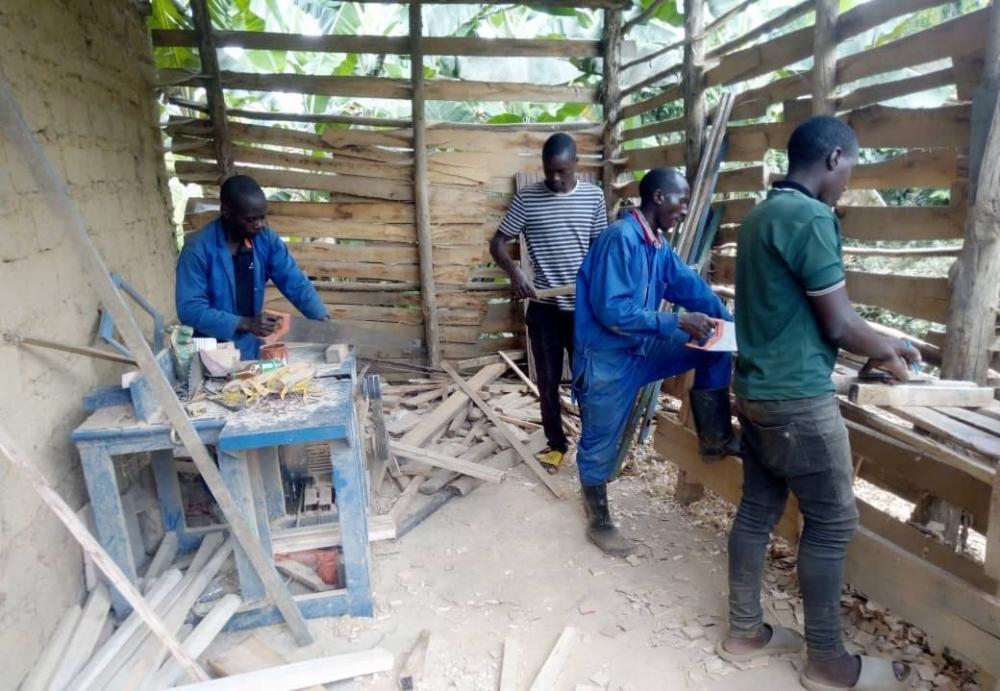Africa-Press – Rwanda. Sawdust has for long been discarded and burnt as waste in Rwanda. But getting rid of the dust from woodwork is no longer the right thing to do as the material is being reimagined not just as a moneymaking product but a tool for environmental protection.
Sawdust is attracting investors across multiple sectors, from brickmaking to mushroom farming, and now sawyers say they can’t meet growing demand.
François Ruziga, a sawyer based in Rusizi District, produces at least 20 sacks of sawdust daily, each weighing 100 kilogrammes. He recalls how, just a few years ago, sawdust was nothing more than a burden.
“When I started the sawing business in 2019, we used to burn the sawdust. There was no demand. Rather than helping the environment, it was polluting it,” he said.
By 2021, however, local farmers had begun using sawdust as bedding for livestock.
“At first, it was an unstable business. Farmers offered around Rwf300 per 100kg sack,” Ruziga recalled.
Today, demand is steadier and growing. “In 2024, the price rose to Rwf1,000 per sack. Now, it’s at Rwf2,000, and there are times when we can’t even meet the demand,” he added.
While farmers remain the largest buyers of sawdust in Rusizi, Ruziga noted that other sectors have entered the market too, some using it to make environmentally friendly products.
In Musanze District and in the City of Kigali, Emmanuel Musangamfura is among those diversifying its use.
“As a mushroom farmer, I rely on sawdust for growing mushroom spawn. I’m also involved in manufacturing MDF wood and other construction boards, blending sawdust with other materials,” he said.
He recalls how brickmakers were once the only regular buyers of sawdust when he started using it in mushroom farming.
“Today, eucalyptus sawdust is most preferred due to its quality. However, it is usually mixed with other types of wood to make up a full truckload,” he explained.
A truckload of sawdust currently fetches around Rwf600,000 in Kigali, and about Rwf400,000 in areas like Musanze. Musangamfura sources an average of two trucks daily from major sawyers.
Germain Hirwa, Managing Director of OAK Investment, a company specialising in clean cooking technologies, said sawdust has become indispensable in producing biomass briquettes.
“We rely on it as a key raw material. From four to five truckloads, we can produce up to 20 tonnes of briquettes,” he said. Prices currently stand at Rwf300 per kilogramme of non-carbonised briquettes and Rwf800 for carbonised ones.
But as demand for sawdust rises across various sectors, shortages are beginning to bite.
“We now need at least 15 truckloads each day,” Hirwa said. “Over the past year alone, the cost per truck has jumped from Rwf300,000 to Rwf400,000. It’s becoming a challenge for production.”
The next import?
To help bridge the gap, Hirwa is calling for government intervention: “We propose tax-free importation of sawdust and permission to harvest state-owned bamboo and papyrus as alternative sources.”
Abdul Karemera, Chairperson of the Rwanda Wood Value Chain Association, confirmed the growing interest in sawdust, especially for brickmaking.
“It’s commonly used in bricks that are lighter, more porous, and offer better thermal insulation,” he said. “Brick making is booming, not just in Kigali but across the country. That’s pushing up sawdust demand.”
To meet that demand, Karemera said the association plans to deepen its involvement in the sawdust value chain and explore solutions to support the sector’s development.
From an urban development perspective, Enrico Morriello, an urban development adviser at the Swiss Agency for Development and Cooperation (SDC), which is supporting the Rwanda’s urbanisation drive, sees sawdust as a cost-effective and eco-friendly alternative.
“With an estimated 50 million bricks produced annually in Rwanda, around 10,000 tonnes of sawdust, or about 2,800 truckloads, are needed,” Morriello said.
“If the same production used firewood, it would consume around 5,000 hectares of forest each year. Sawdust not only reduces deforestation but also cuts carbon emissions by nearly 50,000 tonnes of CO2 annually. It’s among the most efficient biofuels we have,” he said.
He added that coffee husks also serve a similar purpose, though they’re less accessible than sawdust.
At the grassroots level, small-scale operators are also feeling the impact of shifting demand.
Immaculée Umutoni, president of APARWA, a cooperative of dealers in wood and building materials in Gisozi Sector, Gasabo District, said sawdust demand fluctuates according to the season.
“During the rainy season, demand slows down. But in the dry season, especially when brickmaking increases, business improves,” Umutoni said.
“Currently, a truckload sells for around Rwf500,000, but during the wet season, that can fall to Rwf300,000. We usually produce one truck a day.”
Meanwhile, the government is looking into ways to support sawdust-based innovation.
Christian Sekomo Birame, Director General of the National Industrial Research and Development Agency (NIRDA), told The New Times that the agency is exploring collaboration with the private sector players to produce high-quality MDF boards.
“One of the main challenges is ensuring cleaner sawdust collection. Currently, it often gets mixed with dust and other waste,” he noted.
“In some countries, sawing systems are connected directly to collection sacks, preventing contamination. Then it is stored clean and ready for processing.”
Birame said NIRDA is working with the Rwanda Wood Value Chain Association to introduce similar systems in Rwanda.
For More News And Analysis About Rwanda Follow Africa-Press






